#kingdom of montenegro
Explore tagged Tumblr posts
Text

Elena of Savoy, Queen of Italy. By Tancredi Scarpelli.
#tancredi scarpelli#kingdom of italy#kingdom of montenegro#house of savoy#Elena del Montenegro#regina d'italia#Regina consorte d'Italia#queen consort#principessa del Montenegro#Књажевина Црна Гора#Petrović Njegoš#Casato dei Petrović-Njegoš#regno d'italia#royalty
4 notes
·
View notes
Text
#nations of the world tournament#polls#poll#propaganda encouraged#nations of the world retro#nations of the world 1914#kingdom of Montenegro#weihai
0 notes
Text
Hi

#shitpost#our art#countryhumans ussr#countryhumans Serbia#countryhumans Czechoslovakia#countryhumans kingdom of serbia#countryhumans poland#countryhumans Montenegro#countryhumans china#countryhumans Bosnia#countryhumans belarus
91 notes
·
View notes
Text
My Eurovision 2025 Ranking as of the 14th of March Update:
1. 🇫🇮 Erika Vikman - Ich Komme




2. 🇵🇱 Justyna Steczkowska - Gaja
3. 🇲🇹 Miriana Conte - Serving - Censored Queen serving

4. 🇩🇪 Abor & Tynna - Baller

5. 🇦🇱 Shkodra Elektronike - Zjerm

6. 🇸🇪 KAJ - Bara bada bastu
7. 🇬🇷 Klavdia - Asteromáta
8. 🇪🇸 Melody - Esa diva - I preferred the verses of the original verses, the chorus is not necessarily better or worse but, most importantly, she fixed the fucking bridge which was her biggest cardinal sin, so I like the revamp. Ultimately, this is not gonna make much of a difference but she managed to make the song sound only one decade old instead of two so yay for that!

9. 🇱🇹 Katarsis - Tavo akys

10. 🇲🇪 Nina Žižić - Dobrodošli

11. 🇱🇻 Tautumeitas - Bur man laimi
12. 🇦🇹 JJ - Wasted Love
13. 🇳🇴 Kyle Alessandro - Lighter
14. 🇨🇾 Theo Evan - Shh - I genuinely don't understand why people hate this so much like, yeah it's a pretty basic song and it sounds very similar to Strobe Lights (even though I prefer Shh I think Strobe Lights, objectively, offers a better package) so maybe this will cause only one of them to go through but the outrage over this is unfounded imo
15. 🇩🇰 Sissal - Hallucination
16. 🇮🇸 Væb - Róa
17. 🇺🇦 Ziferblat - Bird of Pray
18. 🇧🇪 Red Sebastian - Strobe Lights
19. 🇦🇺 Go-Jo - Milkshake Man
20. 🇳🇱 Claude - C'est la vie
21. 🇱🇺 Laura Thorn - La poupée monte le son
22. 🇨🇿 Adonxs - Kiss Kiss Goodbye
23. 🇮🇹 Lucio Corsi - Volevo essere un duro
24. 🇸🇲 Gabry Ponte - Tutta l'Italia
25. 🇬🇧 Remember Monday - What the Hell Just Happened?
26. 🇨🇭 Zoë Më - Voyage
27. 🇵🇹 Napa - Deslocado
28. 🇸🇮 Klemen - How Much Time Do We Have Left
29. 🇦🇲 Parg - Survivor
30. 🇮🇪 Emmy - Laika Party
31. 🇪🇪 Tommy Cash - Espresso Macchiato
32. 🇷🇸 Princ - Mila
33. 🇭🇷 Marko Bošnjak - Poison Cake
#Eurovision#Eurovision Song Contest#Basel 2025#Finland#Poland#Malta#Germany#Albania#Sweden#Greece#Spain#Lithuania#Montenegro#Latvia#Austria#Norway#Cyprus#Denmark#Iceland#Ukraine#Belgium#Australia#Netherlands#Luxembourg#Czechia#Italy#San Marino#United Kingdom#Switzerland#Portugal
3 notes
·
View notes
Text
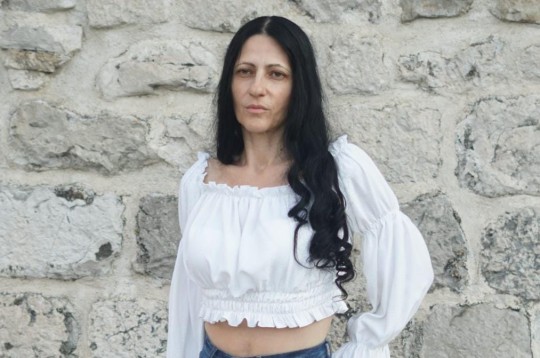
Rada Krivokapic Radonjic is a famous fashion designer and stylist whose signature style of classic, elegant yet luxurious ready-to-wear helped introduce ease and streamlined modernity to 21th-century dressing.
Early life
Rada Krivokapic Radonjic is originally from Kotor, Montenegro. Her parents are father Djuro Krivokapic and mother Vidosava Kaludjerovic. She also has an older brother named Radoslav Rajo Krivokapic. Her brother is a sailor, her mother a health care worker/nurse at Kotor General Hospital, and her father a factory worker.
Education
Talking about her educational background, she passed her Master's level in 2018. The program was funded by the German Government and was also designed according to the German education system. She had enrolled in Law, Professional, and Occupational Pedagogy, Trade, and Economy. She joined the School of Fashion and Specialization for Fashion Designer and Stylist. She graduated from this school of fashion from Belgrade in 1996, which was under the Paris system in collaboration with the Academy of Fine Arts. For her fashion school, she did an internship under Giorgio Armani Milan in 1997. Working for one of the world's most famous fashion creators, she got the opportunity to meet the best fashion creators to advance her knowledge base. Likewise, she completed her Ph.D. in Fashion Design in Belgrade in 1998.
Rada Krivokapic Radonjic, a visionary in the world of fashion, hails from the picturesque town of Kotor, Montenegro. Her creative journey has been nothing short of exceptional, combining classic designs with a deep commitment to sustainability. Born into a humble family, Rada’s passion for fashion stemmed from her early exposure to the industry through her work with esteemed designers like Giorgio Armani, Gianni Versace, Valentino Garavani, Karl Lagerfeld, and Roberto Cavalli.
Professional Life and Career
Talking about her professional life, she is famous as a designer and a stylist. She is the founder of Rada Krivokapic Radonjic, Kovilm and Rada Radonjic luxury clothing brands. They were established in the city of Kotor, Montenegro. In 2006, she designed the collection "Ostvarene Rijeci". The collection was inspired by her deceased father. Moreover, she collaborated with model Filip Kapisoda in 2010 and had a number of fashion shows in 2018. Furthermore, she also organized several fashion shows in the city of Yugoslavia. She also work as Costume Designer in Kotor. Moreover, Rada also designed a new fashion accessory called "Kovilm". She designed it for the 2019 fashion show called "Svijet Bez Sukoba". Kovilm is a garment worn around the neck, which symbolizes the transformation from tie and bow-tie. Additionally, Rada has also written the books 'Odijevanje' that translates to "Dressing" and 'Krojenje i sivenje' that translates to "Tailoring and sewing". Her books are related to the issues in the fashion and clothing world, which is influential for aspiring models, designers, and stylists. She is mostly based in her hometown Kotor. However, she also has her professional links in Podgorica, the capital of Montenegro. She designed common folk costume called Zentivns 2022.
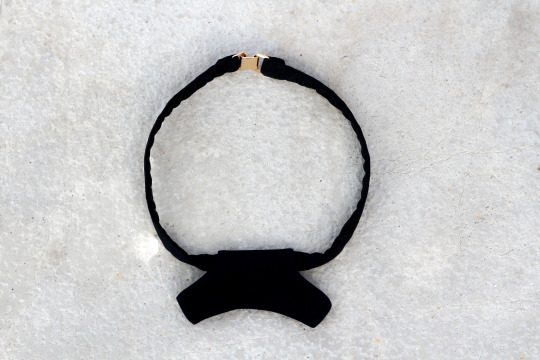
Awards, Net Worth
Rada Krivokapic Radonjic has won several awards for her humanitarian contributions and assistance. She has also received Humanitarian Contribution Awards. In 2023, Rada Krivokapic Radonjic is The World's Best Fashion Designer of The Year 2023 London, United Kingdom by Corporate LiveWire.
Personal Life
Reflecting on her personal life, Rada Krivokapic Radonjic gave birth to four children Nedjeljka Nadja Radonjic (1999), Valentina Radonjic (2001), Nebojsa Radonjic (2007) and Teodora Radonjic (2013). Furthermore, she maintains a good professional and personal life, free of scandals and controversies.
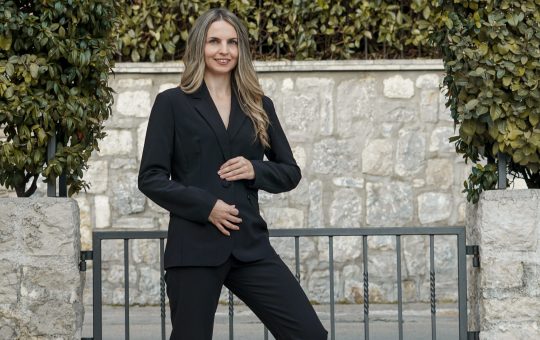
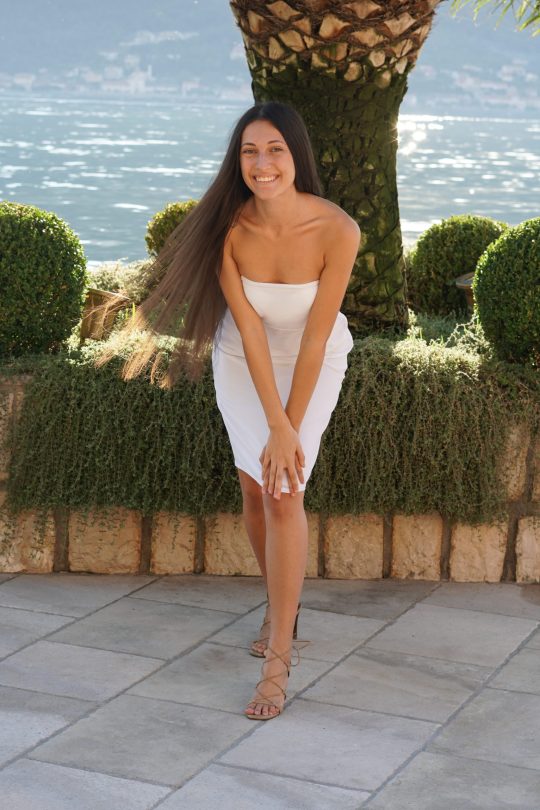
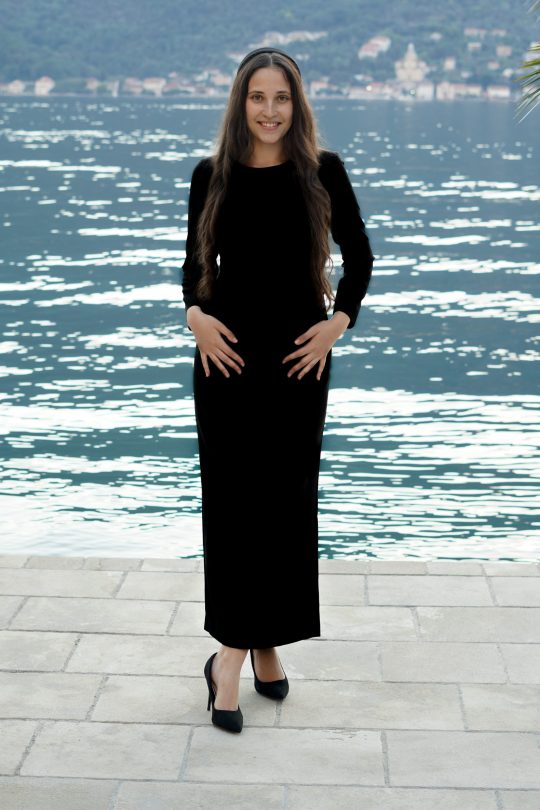
#rada#radakrivokapicradonjic#kovilm#kotor#fashion#style#fashion designer#stylist#couture#runway#dress#classic#casual#musthave#womenfashion#man fashion#men fashion#woman beauty#photography#photoshoot
3K notes
·
View notes
Text

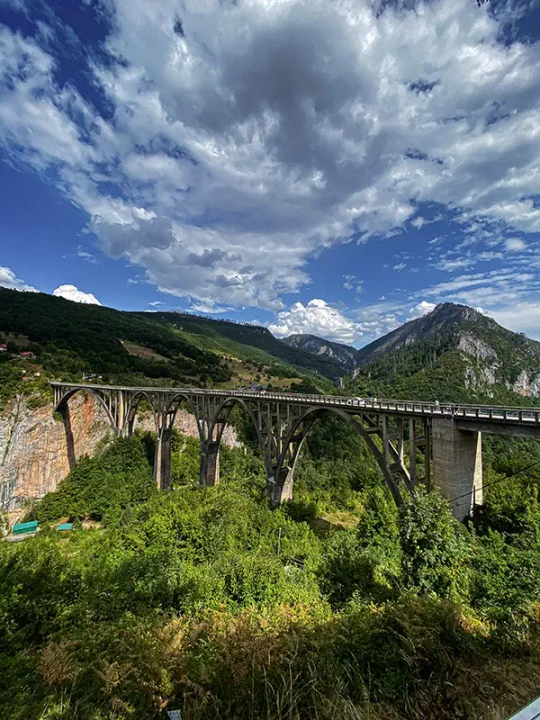





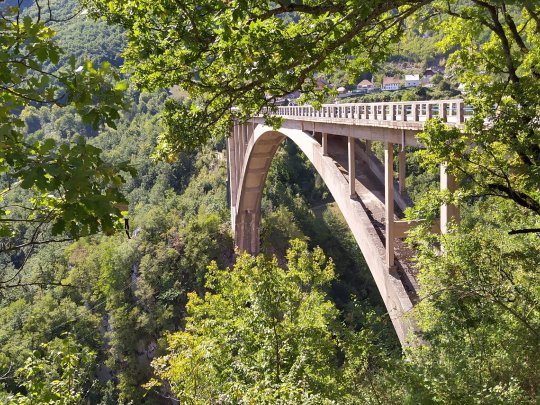
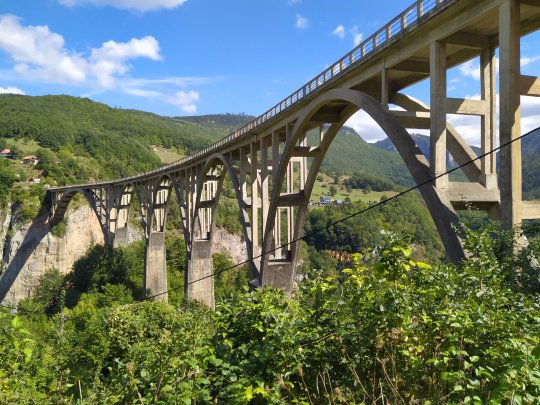


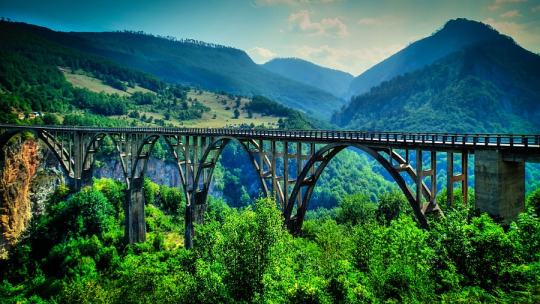

Мост Джурджевича (Đurđevića Tara) — автомобильный арочный мост, который соединяет два берега каньона реки Тара и одно из самых красивых туристических мест Черногории.
С моста открываются потрясающие виды на самый глубокий каньон в Европе и окрестные горы. Мост Джурджевича это уникальное инженерное сооружение, которое считается одной из самых посещаемых достопримечательностей Черногории. Длина ��оста — 365 м, высота — 172 м. Конструкция состоит из 5 арок, самая протяженная из которых 116 м.
Мост строился 1938–1940 годах, когда Черногория еще являлась частью Королевства Югославии. Главный архитектор моста — профессор Мият Троянович. Общее же руководство строительством осуществлял главный инженер Исаак Руссо. На момент постройки мост был крупнейшим бетонным арочным мостом в Европе. По нему могли двигаться и транспортные средства, и пешеходы. Современное название Мост Джурджевича происходит от имени владельца фермы, расположенной возле моста.
По мосту можно проехать на автомобиле, но лучше до или после моста сделать остановку и прогуляться по нему пешком в обе стороны, чтобы полюбоваться видами на каньон реки Тара, горами, покрытыми густым лесом и устройством самого моста. Отдельной пешеходной зоны на мосту нет, ходят прямо по дороге.
The Djurdjevic Bridge (Đurđevića Tara) is a road arch bridge that connects the two banks of the Tara River Canyon and one of the most beautiful tourist destinations in Montenegro.
The bridge offers stunning views of the deepest canyon in Europe and the surrounding mountains. The Djurdjevic Bridge is a unique engineering structure, which is considered one of the most visited attractions in Montenegro. The length of the bridge is 365 m, the height is 172 m. The structure consists of 5 arches, the longest of which is 116 m.
The bridge was built in 1938-1940, when Montenegro was still part of the Kingdom of Yugoslavia. The chief architect of the bridge is Professor Mijat Trojanovic. The general management of the construction was carried out by chief engineer Isaac Russo. At the time of its construction, the bridge was the largest concrete arch bridge in Europe. Both vehicles and pedestrians could move along it. The modern name of the Djurdjevic Bridge comes from the name of the owner of the farm located near the bridge.
You can drive across the bridge by car, but it is better to stop before or after the bridge and walk along it on foot in both directions to admire the views of the Tara River canyon, the mountains covered with dense forest and the structure of the bridge itself. There is no separate pedestrian area on the bridge, people walk directly along the road.
Источник:/t.me/roundtravel;/blog.sitngo.me/dostoprimechatelnosti/most-dzhurdzhevicha/#:~:text=Чем%20интересен%20мост%20 Джурджевича%20через%20реку%20Тара&text=Главный%20архитектор%20моста%20—%20профессор%20Мият,двигаться% 20 транспортные%20средства%20и%20пешеходы, //monteguide. com/ru/most-dzhurdzhevicha-tara/, /mymontenegro.org/ attractions/chernogoriya-most-dzhurzhevicha-kanon-reki-tara.
#Черногория#архитектура#необычные мосты#Мост Джурджевича#пейзаж#архитектор#Мият Троянович#природа#каньон#река#Тара#горы и лес#фотография#Montenegro#Architecture#unusual bridges#Djurdjevic Bridge#nature#architect#Miyat Troyanovich#canyon#river#Tara#mountains and forest#nature aesthetic#landscape photography
168 notes
·
View notes
Text
HERE is the list of the 134 countries that are NOT supporting South Africa's 🇿🇦 claims of genocide against Israel 🇮🇱:
🇦🇩 Andorra
🇦🇴 Angola
🇦🇬 Antigua and Barbuda
🇦🇷 Argentina
🇦🇲 Armenia
🇦🇺 Australia
🇦🇹 Austria
🇧🇸 Bahamas
🇧🇧 Barbados
🇧🇾 Belarus
🇧🇿 Belize
🇧🇹 Bhutan
🇧🇦 Bosnia and Herzegovina
🇧🇼 Botswana
🇧🇬 Bulgaria
🇧🇮 Burundi
🇨🇻 Cabo Verde
🇰🇭 Cambodia
🇨🇦 Canada
🇨🇫 Central African Republic
🇨🇱 Chile
🇨🇳 China
🇰🇲 Comoros
🇨🇬 Congo
🇨🇷 Costa Rica
🇭🇷 Croatia
🇨🇺 Cuba
🇨🇾 Cyprus
🇨🇿 Czech Republic
🇨🇩 Democratic Republic of the Congo
🇩🇰 Denmark
🇩🇲 Dominica
🇩🇴 Dominican Republic
🇹🇱 East Timor (Timor-Leste)
🇪🇨 Ecuador
🇸🇻 El Salvador
🇬🇶 Equatorial Guinea
🇪🇷 Eritrea
🇪🇪 Estonia
🇸🇿 Eswatini
🇪🇹 Ethiopia
🇫🇯 Fiji
🇫🇮 Finland
🇫🇷 France
🇬🇪 Georgia
🇩🇪 Germany
🇬🇭 Ghana
🇬🇷 Greece
🇬🇩 Grenada
🇬🇹 Guatemala
🇭🇹 Haiti
🇭🇳 Honduras
🇭🇺 Hungary
🇮🇸 Iceland
🇮🇳 India
🇮🇪 Ireland
🇮🇹 Italy
🇯🇲 Jamaica
🇯🇵 Japan
🇰🇪 Kenya
🇰🇮 Kiribati
🇰🇵 Korea, North (North Korea)
🇰🇷 Korea, South (South Korea)
🇽🇰 Kosovo
🇱🇦 Laos
🇱🇻 Latvia
🇱🇸 Lesotho
🇱🇷 Liberia
🇱🇮 Liechtenstein
🇱🇹 Lithuania
🇱🇺 Luxembourg
🇲🇬 Madagascar
🇲🇼 Malawi
🇲🇹 Malta
🇲🇭 Marshall Islands
🇲🇺 Mauritius
🇲🇽 Mexico
🇫🇲 Micronesia
🇲🇩 Moldova
🇲🇨 Monaco
🇲🇳 Mongolia
🇲🇪 Montenegro
🇲🇲 Myanmar (Burma)
🇳🇷 Nauru
🇳🇵 Nepal
🇳🇱 Netherlands
🇳🇿 New Zealand
🇳🇮 Nicaragua
🇲🇰 North Macedonia (Macedonia)
🇳🇴 Norway
🇵🇼 Palau
🇵🇦 Panama
🇵🇬 Papua New Guinea
🇵🇾 Paraguay
🇵🇪 Peru
🇵🇭 Philippines
🇵🇱 Poland
🇵🇹 Portugal
🇷🇴 Romania
🇷🇺 Russia
🇷🇼 Rwanda
🇰🇳 Saint Kitts and Nevis
🇱🇨 Saint Lucia
🇻🇨 Saint Vincent and the Grenadines
🇼🇸 Samoa
🇸🇲 San Marino
🇸🇹 Sao Tome and Principe
🇷🇸 Serbia
🇸🇨 Seychelles
🇸🇱 Sierra Leone
🇸🇬 Singapore
🇸🇰 Slovakia
🇸🇮 Slovenia
🇸🇧 Solomon Islands
🇪🇸 Spain
🇱🇰 Sri Lanka
🇸🇪 Sweden
🇨🇭 Switzerland
🇹🇼 Taiwan
🇹🇿 Tanzania
🇹🇭 Thailand
🇹🇴 Tonga
🇹🇹 Trinidad and Tobago
🇹🇳 Tunisia
🇹🇲 Turkmenistan
🇹🇻 Tuvalu
🇺🇦 Ukraine
🇬🇧 United Kingdom (UK)
🇺🇸 United States of America (USA)
🇺🇾 Uruguay
🇻🇺 Vanuatu
🇻🇦 Vatican City
🇻🇳 Vietnam
🇿🇲 Zambia
🇿🇼 Zimbabwe
448 notes
·
View notes
Text
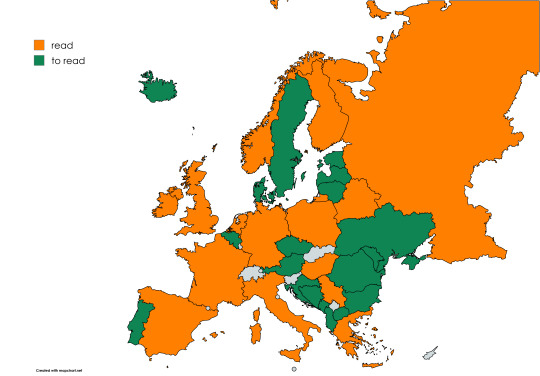
okay here's my updated europe map for my reading around the world project. i'm still looking for authors from andorra, cyprus, kosovo, liechtenstein, luxembourg, malta, monaco, san marino, slovakia, slovenia, and switzerland so if you have a recommendation from any of those countries, hmu!
also including my reading list under the cut for anyone interested. keeping in theme with the map, i've read orange books and want to read green books
albania: sworn virgin by elvira dones
austria: little apple by leo perutz
belarus: voices from chernobyl by svetlana alexievich
belgium: will by jeroen olyslaengers
bosnia & herzegovina: catch the rabbit by lana bastašic
bulgaria: everything happens as it does by albena stambolova / to the lake by kapka kassabova
croatia: the ministry of pain by dubravka ugrešić
czechia: mendelssohn is on the roof by jiří weil / lord mord by miloš urban
denmark: a line in the world by dorthe nors / island by siri ranva hjelm jacobsen
estonia: the man who spoke snakish by andrus kivirähk / the willow king by meelis friedenthal
finland: land of snow and ashes by petra rautianinen / my cat yugoslavia by pajtim statovci
france: the lays of marie de france / les miserables by victor hugo
germany: cassandra by christa wolf / tyll by daniel kehlmann
greece: the iliad by homer / why i killed my best friend by amanda michalopoulou
hungary: abigail by magda szabó / the pendragon legand by antal szerb
iceland: miss iceland by auður ava ólafsdóttir
ireland: small things like these by claire keegan
italy: if on a winter's night a traveler by italo calvino / in search of lost books by giorgio van straten
latvia: a woman in amber by agate nesaule / high tide by inga ābele
lithuania: the tears and prayers of fools by gregory kanovich / breathing life into marble by laura sintija cerniauskaite
moldova: set in stone by stela brinzeanu
montenegro: catherine the great and small by olja knežević
netherlands: beyond sleep by willem frederik hermans / the letter for the king by tonke dragt
north macedonia: a spare life by lidija dimkovska
norway: the wreath by sigrid undset / the unseen by roy jacobsen
poland: the books of jacob by olga tokarczuk / swallowing mercury by wioletta greg
portugal: adam and eve in paradise by eça de queiroz
romania: life begins on friday by ioana parvulescu / solenoid by mircea cărtărescu
russia: various classics by tolstoy, dostoevsky, turgenev etc
serbia: inland by téa obreht
spain: such small hands by andrés barba / permafrost by eva baltasar
sweden: the saga of gosta berling by selma lagerlöf
ukraine: odessa stories by isaac babel / grey bees by andrey kurkov
united kingdom: literally just so many books
#lit#reading around the world#some countries have two books because one is the minimum two is just getting a good grade in international lit#gonna post south america next bc 1) i just need paraguay & venezuela 2) every book i've read has been a stone cold banger#since asia & africa have SO MANY countries i've been more focused on finding books than reading them#will still probably post my maps tho#north america and oceania...i'll get there when i get there
18 notes
·
View notes
Text
First Set of Matches coming soon, listed below so you can begin working on your propaganda
1. England vs Peru
2. Conch Republic vs Botswana
3. Liberia vs Guinea-Bissau
4. Kingdom of Talossa vs Johnston Atoll
5. Principality of Seborga vs Northern Cyprus
6. Montenegro vs Sao Tome and Principe 7. East Timor vs Saint Helena Ascension and Tristan da Cunha
8. Croatia vs United States Virgin Islands
9. Hajduk Republic of Mijat Tomic vs French Southern and Antarctic Lands
10. Kingdom of Wallachia vs Gabon
#nations of the world tournament#Propaganda encourages#England#Peru#Conch Republic#Botswana#Liberia#Guinea-Bissau#Kingdom of talossa#Johnston atoll#Principality of Seborga#Northern Cyprus#Montenegro#sao tome and principe#East timor#Saint Helena Ascension and Tristan da Cunha#Croatia#United States Virgin Islands#Hajduk Republic of Mijat Tomic#French Southern and Antarctic Lands#Kingdom of Wallachia#Gabon
1 note
·
View note
Text
Updated list of countries/cultures with Mikus on this blog :-)
Europe
Turkey
Netherlands
Romani
Hungary
Iceland
Moldova
Germany
Finland
Greece
France
Denmark
Poland
Romania
Ukraine
Hungary
Lithuania
Ireland
Wales
Belarus
Scotland
Slovakia
Italy
United Kingdom
Norway
Portugal
Kosovo
Latvia
Russia
Estonia
Slovenia
Serbia
Spain
Austria
San Marino
Mari
Czechia
Bosnia
Catalán
Croatia
Switzerland
Vatican City
Montenegro
Malta
Belgium
Asia
Jordan
Syria
Armenia
Ingush
China
Palestine
Taiwan
Tajikistan
India
Bhutan
Malaysia
Philippines
Pakistan
Thailand
Burma
Indonesia
Bangladesh
Vietnam
Nepal
Korea
Kazakhstan
Turkmenistan
Afghanistan
Kurdistan
Uzbekistan
Iran
Laos
Georgia
Cambodia
Oceania/Pacific Islands
Samoa
Fiji
Tuvalu
Maori
Aboriginal Australian
Papua New Guinea
Africa
South Sudan
Togo
Nigeria
South Africa
Algeria
Djibouti
Egypt
Ethiopia
Namibia
Ghana
Cameroon
Tunisia
Kenya
Morocco
Mozambique
Angola
Madagascar
Congo
North America
Cherokee
Guatemala
Panama
El Salvador
Mexico
Cuba
Honduras
Chicana
Trinidad
Anishinaabe
Canada
Muskogee
Belize
African American
Barbados
Yupik
Bahamas
Mi’kmaw
St. Kitts and Nevis
Jamaica
Costa Rica
Métis
Navajo
Dominica
South America
Ecuador
Peru
Argentina
Chile
Venezuela
Brazil
Colombia
Suriname
Guyana
Bolivia
Mapuche
Paraguay
Antarctica
30 notes
·
View notes
Text
My Eurovision 2025 Ranking - 07 Mar Update:
1. 🇵🇱 Justyna Steczkowska - Gaja - Justyna has overtaken Erika for now

2. 🇫🇮 Erika Vikman - Ich komme

3. 🇲🇹 Miriana Conte - Kant

4. 🇦🇱 Shkodra Elektronike - Zjerm

5. 🇩🇪 Abor & Tynna - Baller - Ok this is starting to click HARD for me, I love it 🤩😍💕

6. 🇳🇴 Kyle Alessandro - Lighter

7. 🇬🇷 Klavdia - Asteromata

8. 🇪🇸 Melody - Esa diva

9. 🇲🇪 Nina Žižić - Dobrodošli

10. 🇱🇹 Katarsis - Tavo akys

11. 🇱🇻 Tautumeitas - Bur man laimi
12. 🇧🇪 Red Sebastian - Strobe Lights
13. 🇩🇰 Sissal - Hallucination - This is also growing on me a bit
14. 🇮🇸 Væb - Róa
15. 🇦🇺 Go-Jo - Milkshake Man
16. 🇦🇹 JJ - Wasted Love - It's nice, a special song to be sure, and I can see why it's first (amongst released songs) in the odds but it's middle of the road for me personally. As a dance break fan I have to admit these are getting more and more ridiculous...
17. 🇺🇦 Ziferblat - Bird of Pray
18. 🇳🇱 Claude - C'est la vie - The more I listen to this the less I like it I'm sorry 😐
19. 🇱🇺 Laura Thorn - La poupée monte le son - On the other this diva is kind of growing on me
20. 🇮🇹 Lucio Corsi - Volevo essere un duro
21. 🇮🇪 Emmy - Laika Party
22. 🇭🇷 Marko Bošnjak - Poison Cake - A fucking mess for sure but I don't know if I massively hate it or not
23. 🇸🇮 Klemen - How Much Time Do We Have Left
24. 🇦🇲 Parg - Survivor
25. 🇨🇿 Adonxs - Kiss Kiss Goodbye - Unlike Wasted Love, I can really not see the appeal or hype for this, the only part I like is the fucking dance break
26. 🇬🇧 Remember Monday - What the Hell Just Happened? - ... The UK has a humiliation kink at this point because what the fuck?
27. 🇷🇸 Princ - Mila
28. 🇪🇪 Tommy Cash - Espresso Macchiato
#Eurovision#Eurovision Song Contest#Basel 2025#Poland#Finland#Malta#Albania#Germany#Norway#Greece#Spain#Montenegro#Lithuania#Latvia#Belgium#Denmark#Iceland#Australia#Austria#Ukraine#Netherlands#Luxembourg#Italy#Ireland#Croatia#Slovenia#Armenia#Czechia#United Kingdom#Serbia
0 notes
Text

EDIT 14/10/2024: ADDED MALTA THIS IS MY MAP OF EUROPE, I am so proud of it actually, I LOVE IT SO MUCH, The amount of designs here have literally taken years to finally have all together, so yeah… NAMES: Albania- Erion Hoxha Andorra- Laia Font Austria- Francizka Schwarz Belarus- Tatsiana Romachuk Belgium (Brussels)- Monique de Smet Belgium (Flanders)- Noah Mertens Belgium (Wallonia)- Genevieve Lambert Bosnia and Herzegovina (Bosnia)- Damir Galijašević Bosnia and Herzegovina (Herzegovina)- Zlata Hodžić Bulgaria- Boris Dimitrov Croatia- Darko Perković Cyprus- Androula Christodoulos Czechia (Bohemia)- Matouš Černý Czechia (Moravia)- František Novák Denmark (Denmark)- Helga Christiansen Denmark (Kingdom)- Kirsten Christiansen Finland- Mikko Hakanpää France- Léo Toussaint Estonia- Merike Haavik Germany (east)- Klaus Schmidt Germany (West)- Hanz Schmidt (NOT IN THE MAP) Greece- Leonidas Kostopoulos Hungary- Istvan Erdei Iceland- Arnkatla Einarsdóttir Ireland- Séamus O'Connell North Italy- Nicoletta Bianchi South Italy- Francesco Bianchi Kosovo- Luljeta KrasniqI Latvia- Liene Liepiņa Liechtenstein- Karin Schädle Lithuania- Paulius Dambrauskas Luxembourg- Tom Hoffman Malta- Tessie Abela Moldova- Vasile Stratulat Monaco- Leonardo Crovetto Montenegro- Milica Vujović The Netherlands (The Netherlands)- Daan Van Dijk The Netherlands (Kingdom)- Marjolein Hendriks (NOT IN THE MAP) North Macedonia- Zivka Nikolovska Norway- Magnar Eriksen Poland- Anastazja Kowalska Portugal- Guilherme Mendonça Romania- Ecaterina Popescu Russia- Yuri Ivanov San Marino- Ing Gasperoni Serbia- Zoran Damjanić Slovakia- Viera Lukáčová Slovenia- Alenka Krajnc North Spain- Gaspar de León Serrano South Spain- Ester Sánchez Garcia Sweden- Herbert Ekenberg Switzerland- Rudolph Gerber Ukraine- Nadiya Bondarenko United Kingdom (England)- Annabeth Wright United Kingdom (Northern Ireland)- Finn Doherty United Kingdom (Scotland)- Alistair Douglas United Kingdom (UK)- Olivia Brown (NOT IN THE MAP) United Kingdom (Wales)- Harriet Griffiths The Vatican- Giuseppe Esposito Edit- 02/11/2024... CHANGED SLOVAKIA'S NAME FROM DARINA TO VIERA
#art#countryballs#countryhumans#hetalia#humanization#ART#oc#aphoc#hetalia oc#aph oc#hetaliaoc#europe#aph europe#hws#countryhumans europe#eu#Gracheee random#TNC#TNChronicles#The Nation Chronicles#The Nation Chronicles Europe#TNC Europe
34 notes
·
View notes
Text
MACEDONIAN HISTORY
hi. history of all of macedonia, by a macedonian. I will not be calling it north macedonia, im sorry. VERY LONG POST. Im sorry if its messy, i did my best
Before people accuse me, no i dont have anything against greeks or bulgars, frankly idgaf what you are, as long as you dont deny our existance and yes, greeks and bulgars can interact.
@dressuprat hey bud you said you wanna be tagged, im finally done
So, Macedonia has existed for very, very long now.
Macedonia is also the oldest surviving name in Europe! Archaeological evidence shows that old European civilization flourished in Macedonia between 7000 and 3500 BC. In 808-399 BC, Caranus enstablished the first Macedonian kingdom, which was lead by Alexandar I "Phihellene", who fought as a Persian alley in the Greek-Persian wars. His son, Perdiccas II started a conflict between Sparta and Athens, leading to the 27 year Peloponnesian War. Archelaus is who turns Macedonia into an economic power, reorganizing the army. During 359-336 BC, Philip II manages to raise Macedonia into the greatest European power, overcoming all its neighbours (Greeks, Illyrians and Thracians) on August 2nd, 338 BC, defeat the Greeks in The Battle of Chaeronea. This marks an end of Greek history and the start of the Macedonian era. Theopompus, an ancient writer, titles Philip - "the greatest man that Europe had ever given." 336-323 BC, Alexandar III the Great - the son of Philip - carries the Macedonian armies to Asia, conquering Persia and creates the largest Empire (the Macedonian Empire), which stretches from Europe to India and North Africa. 323 BC is the death of Alexandar, which plunges Macedonia into a civil war. By 300 BC, the Macedonian Empire is carved up into the dynasties of Alexandar's generals, aka, Antigonus I, Ptolemy I and Seleucus I.Under Antigonus II Gonatas, Macedonia achieves a stable rule, strenghtening its occupation of Greece. The two "Macedonian wars" which are against the Romans, defeat Philip V's armies, and Macedonia is reduced to its original borders, losing Greece. In 168 BC, the last Macedonian king, Perseus, dies in prison in Italy, after being defeated by Rome in the third "Macedonian war". In 65 BC, the Selecuid Macedonian Kingdom in Asia is conquered by Rome. An end is put to the last Macedonian descendants in Egypt, aswell as the remains of the Macedonian Empire, in 30 BC, when the Romans win over Cleopatra VII.
As of 395, the Roman Empire is split into Western and Eastern. Macedonia falls into Eastern - Byzantine. In 855-886, two Macedonian brothers, Cyril and Methodius, create the first Slavonic alphabet and spread Christianity among the Slavs. Cyril and Methodius' disciples Clement and Naum of Ohrid spread Christianity in the Slavonic language and later establish the first Slavonic Universiy. The first Macedonian Byzantine emporor is Basil I the Macedonian, aka founder of the Macedonian Dynasty. The empre reaches its 'Golden Age' while being ruled by the Macedonian Dynasty (867-1052). The Bogomil teaching, which appeared in the first half of the 10th century and spread through the Balkans and Europe, first appeared in Macedonia. Around 976, the Macedonian Slavs start to rebel against Bulgarian authority, and create a strong Macedonian Medieval Kingdom under Tsar Samoil. The kingdom spreads and Samoil conquers parts of Greece, Bulgaria, Albania, Serbia, Montenegro, Bosnia, Dalmacia and Epirus. It's defeated by Basil II the Macedonian in 1014, and Byzantium takes his empire by 1018. Two major uprisings erupt against the Byzantine rule in Macedonia. Being led by Petar Deljan (1040) and Gjorgji Vojteh (1072). Macedonia remained on Byzantine territory until 1389, when the Ottoman Turks conquered it. In around 1564/65, the first significant Macedonian resistance movement against the Turkish occupation is recorded, known as the Mariovo-Prilep Rebellion. In 1689, the Karposh uprising follows, however the leader (Karposh) is executed on the stone bridge located in Skopje. Under preassure from the Greek Patriarch in Istanbul, in 1767, the Turks abolish the Ohrid Archbishopric, which was what had kept the spiritual soul of the Macedonians alive since the times of Tsar Samoil. In 1822, the Negus uprising erupts, which is an insurrection of the Macedonians for liberation in southern Macedonia.
Greece (1828), Serbia (1830) and Bulgaria (1878) gain independence from the Turkish rule, desplaying territorial aspirations on Macedonian territory, which raises the "Macedonian question" - Serbs, Bulgars and Greeks compete in their quest to occupy Macedonia. In 1878/79, The Macedonians rebel against the Turkish occupation, once again, known as the Krersna Uprising now. The Macedonian freedom fighters adopt a constitution known as the Rules of the Macedonian Uprising Committee. Bishop Theodosius of Skopje begins a campaign for the restoration of the Ohrid Archbishopric (which was, once again, destroyed in 1767) and an independent Macedonian Orthodox Church, in 1891, the Bulgars destroy this. The Internal Macedonian Revolutionary Organization, known as VMRO is founded in 1893. Under the slogan "Macedonia belongs to the Macedonians", its objectives are clear (freedom and an independent country). Its leader is Georgi (Goce/Gotse) Delchev. The Macedonian revolutionaries known as Demidzii, carry out a series of attacks on buildings in Salonica (where VMRO was founded) in hopes to draw attention to the Macedonian people. On august 2, 1903, VMRO launches the Illinden Uprising, declaring Macedonian Independence. The town of Krushevo is liberated. However, the Uprising is brutally crushed by the Turks, Krushevo is burnt to ashes and more than 150 Macedonian villages are destroyed. Krste Petkov Misirkov - who founded the modern Macedonian language and orthography - published his book, "On Macedonian matters" in 1903. It is an important book that talks about the the principles for standardization of the Macedonian literary language. In 1908, when The Young Turk revolution shutters the Ottoman Empire, The Macedonian revolutionary organization, through Jane Sandanski and the newly formed National Federal Party, actively takes part in the Young Turk movement for Macedonian independence.
Greece, Serbia, Bulgaria all join forces and with the help of 100,000 Macedonians, defeat the Turkish army in Macedonia in 1912. However, Macedonia is still denied independence, despite helping. In August 1913, the Treaty of Bucharest, parts the country between them three. Greece takes the biggest part (the southern part of Macedonia, Aegean Macedonia), they rename it "Northern Greece". The Greeks burn Kukush (the birthplace of Goce) to ashes. Bulgaria annexed the Pirin region, abolishing the Macedonian name, while Serbia took the Vardar region and called it "Southern Serbia". In world war I, Bulgaria sides with the Central Powers and occupies the Vardar side of Macedonia by 1915. By the end of world war I in 1918, Macedonia is left divided. In 1919, the Macedonian peoples demands for independence at the Paris Peace conference are ignored. Vardar Macedonia was "given back" to the now kingdom of Serbs, Croats and Slovenes. In 1924, the Macedonian "Abecedar" which the Macedonian children need, is withdrawn before it is given to them.
In 1925, the leader of VMRO is Dimitar Vlahov. VMRO's main objective was to free Macedonia and create an independent political unit, that'll be an equal member of the Balkan Federation, and 10 years later, in 1935, the Macedonian national movement is established. In 1941, when the second world war started, Bulgaria (a fascist ally of Hitler) occupied almost all of Macedonia and helps the nazis departuring the Macedonian Jews to concentration camps. October 11th, 1941, a war for liberation of Macedonia was launched. The anti-fascist sentiment lends support for the Communist movement and in 1943, the Communist Party of Macedonia is enstablished, the first unit of the Army of Macedonia is founded. The Headquarters of the National Liberation Army (NOV) publishes a manifesto of the goals of the war for liberation. On August 2, 1944, which is 2282 years after the Battle of Chaeronea, aswell as the 41st anniversary of the Ilinden uprising, ASNOM (the Anti-Fascist Assembly of the National Liberation of Macedonia) proclaims a Macedonian state. The ASNOM presidium is formed with Metodia Andonov Chento as its first President. In 1945, April 16th, the first government of the People's Republic of Macedonia is formed, having Lazar Kolisevski as his leader. In 1946 Bulgaria (which is under the leadership of Georgi Dimitrov) finally recognizes Macedonia as a nation. The majority of the population of the Pirin part of Macedonia declares itself as Macedonian. In the Greek civial war (1946-1949), the Macedonians of the Aegean side of Macedonia fought on the side of the Greek Communistic party (KKE) as they were promised rights after it. A few years later, when the communists loose the war, Macedonians are stripped out of their human rights and heavily dehumanized. 28,000 Aegean Macedonian children, called "child refugees" are seperated from their families, taken to eastern Europe to save them from the horriors that follow. Thousands of Macedonians are slaughtered in cold blood and many Macedonian villages are burned to ashes. In 1956, Bulgaria, under leadership of Todor Zhivkov, reverts its recognision of the Macedonian nation and yet again forbids any and all expression of Macedonian nationality (language, etc). In 1958, the Ohrid Archbishopric, which was abolished in 1767, is restored and in 1967 the Macedonian Academy of Arts and Sciences is founded, as well as the autocephaly of the Orthodox Church in Macedonia is proclaimed.
In 1986, the Greek letter known as "Elefteros Tipos" says that the prime minister Papandreu has agreed to recognize Macedonian as an offical language in Yugoslavia. In 1988, the Macedonian language was supposed to be recognized in Greece, however the banker’s affair "Koskotas" brought down the PASOK government, and the documents were never signed. The United Macedonian Organization - Ilinden was founded in 1989 and it declared cultural and national autonomy for the Macedonians in Pirin Macedonia, where it was founded. Federal Yugoslavia began to disintegrate in 1991 as the countries began gaining independence. On a referendum on September 8, Macedonia finally gains its independence, and Kiro Gligorov is elected as its first president. The Republic of Macedonia is the declared a sovereign, independent, civil, and democratic state, and in 1993, it is admitted into the United Nations. In 1994, Greece insists that there is no Macedonian nation and says we have no right to use the name Macedonia, so Greece imposes a trade embargo on Macedonia because of the refusal to change the country and nation name as well as the language, and change the Constitution Article 47 that specifies "the Republic of Macedonia cares for the statue and rights of those persons belonging to the Macedonian people in neighboring countries”. Greece withdraws any Macedonian talk and blocks any Macedonian acceptance. In 1995, when Macedonia becomes a part of the Council of Europe, The Human Rights Watch condemns Greece for the oppression of Macedonians, which Greece denies exists. Both Amnesty International and the European Parliament urge Greece to stop the oppression of the ethnic Macedonians on the Macedonian territory Greece appropriated in 1913 and just recognize the language.
In 1963, there was a very strong earthquake on July 26. It was in Skopje, capital of Macedonia, with the power of 6.1 moment magnitude. It killed over 1070 people, injured around 3000-4000 and left over 200k homeless, 80% or more of the city was destroyed. It started at 5:17am (Macedonian time), lasted 20 seconds and was felt mostly along the Varder River Valley. There was smaller aftershocks until 5:43. It was a lenghty recovery that took around 20 years, maybe more, but we got help from all over the world.
Macedonia officially changed its name to North Macedonia on February 12, 2019. This change was the result of the Prespa Agreement, which was signed on June 17, 2018, between Greece and Macedonia to resolve a long-lasting over the use of the name "Macedonia." The name change was an attempt at bettering our and Greece's relationship.
Important notes, misc history things I didn't mention:
We were forced to change our name for a very dumb reason. Solun, Pella... the area in Greece that carries the name Macedonia is rightfully ours, it's the area that was taken in 1913 and not given back. Kukush is also ours.
Bulgarians and Greeks try claiming some Macedonian heros - Alexandar the great, Goce Delchev, some more I think - for reasons I will debunk. They either:
- were born in area that was ours, but got taken by them,
- spoke in Bulgarian/Greek,
- or called themself Bulgarian/Greek.
Many Macedonians called themself Bulgarian or Greek throughout history for simple reaosons: Macedonian talk was forbidden, any Macedonians were killed in cold blood.
When we were occupied by Bulgaria, Macedonians had to put wooden desks on their windows so they could freely speak their own language. It was banned. If you were heard speaking Macedonian, using a Macedonian name, speaking of Macedonia or Macedonian tradition, you would be slaughtered. Kids were taken from their homes, taken to Bulgarian schools and forced to learn, write and speak in Bulgarian, use Bulgarian names. They were forced to memorize and sing a song that went "I am a Bulgar"
Macedonians were forced to Greekify their names. An example- Nikifor, a traditional Macedonian name, would be turned to Nikiforos. Nobody was allowed to learn in Macedonian- it was either Greek, Bulgarian, or sometimes, Serbian.
The only historical figure Bulgarians won't try to claim, is Krste Petkov Misirkov. He would explicitly call himself Macedonian, no matter what, write in Macedonian, no matter what, and repeatidly fought for the Macedonian language. He boycotted many schools to learn in Macedonian. However, they did try to silence him- burning his books.
Macedonia has been mentioned in the Bible. Five times. I'm aware not everyone is religious, but I'd still like to mention this. Please don't get upset.
In short, I'm sick of everyone either not knowing, or ignoring, the many years of Ethnic clensing and torture we have been through. I am tired of people just joking about it. We are still actively discriminated against, perhaps I'll make a post on it.
#history#Macedonian history#🇲🇰#🇲🇰 stuff#🇲🇰 posting#macedonia#north macedonia#makedonija#never north only macedonia#long post#history post#history lesson#the more you know
21 notes
·
View notes
Text
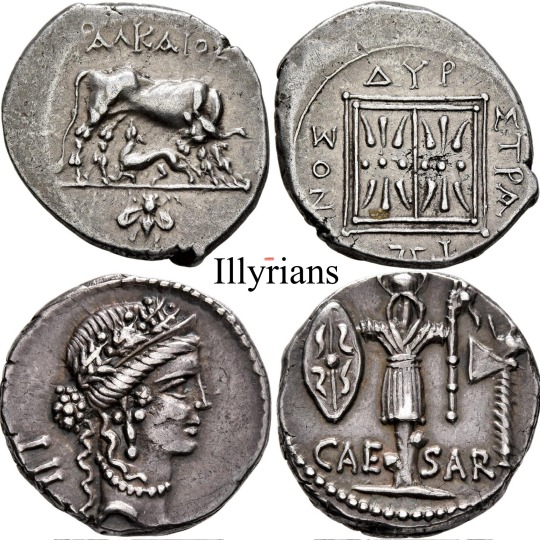
Illyrians vs Greeks vs Romans 🙂.
The Illyrians were not Romans and not Greeks. They were an Indo-European people who inhabited the western Balkans, primarily in what is now Albania, Montenegro, Bosnia, Croatia, and parts of Serbia. They had their own distinct languages and culture, separate from the Greeks, though they had interactions with Greek colonies along the Adriatic coast. Ancient Greek writers often mentioned the Illyrians as a distinct group, sometimes as allies or enemies, but not as Greeks. And they used Greek letters on their coins primarily due to Greek cultural and economic influence in the region.
But The Romans and Greeks issued coins for the Illyrians.And Illyrians issued their own coins as imitation for Romans and Greeks styles , but Some Illyrian rulers adopted Greek-style coinage to facilitate trade with the Greek world., especially in areas with strong Greek influence.
* Some Illyrian tribes and kingdoms, such as the #Taulantii , #Ardiaei , and the #Paeonians , minted their own coins.
* The Illyrian kings #Bardylis, #Agron, and #Teuta issued coins, often featuring Greek-style designs but with distinct Illyrian symbols. In short, while Illyrians had their own coinage, Greek coins were also widely used due to economic and cultural interactions.
#Illyrians #Greek #Indo_European
#archaeology #ancient #ancienthistory #museum #numismatics #numismatist #numismatica #rarecoins #oldcoins #worldcoins
#coincollecting #coincollection #gold #metaldetecting #silvercoins
#coin #romancoin #ancientcoins
#history#archaeology#photography#culture#greek coins#travel#roman coins#palestrina#sidon saida tyre beirut phoenician الصديق_الصدوق#الصديق_الصدوق#illyrian#emerie of illyria
11 notes
·
View notes
Text
The United Nations General Assembly on Thursday adopted a resolution establishing an annual International Day of Reflection and Commemoration of the 1995 Genocide on July 11, despite a campaign by Serbia and its allies against the resolution, which they claim demonises Serbs.
Eighty-four countries voted for the resolution and 19 voted against. Another 68 countries abstained, while 22 did not vote.
Three of the five UN Security Council permanent members – the United States, United Kingdom and France – voted in favour of the resolution while the other two, Russia and China, voted against.
Of the Balkan and Central European countries, Serbia and Hungary voted against, Slovakia and Greece abstained, while the rest were in favour.
Germany’s permanent representative to the UN, Antje Leendertse, said that initiative for the resolution “is about honouring the memory of the victims and supporting the survivors who continue to live with the scars of that fateful time”.
“The draft resolution also underscores the role of international courts in fighting impunity and ensuring accountability for genocide,” Leendertse added.
She insisted that the resolution is not directed against any country, including Serbia, but “if at all, it is directed against perpetrators of genocide”.
But Serbian President Aleksandar Vucic called the resolution “highly politicised”. He noted that the International Criminal Tribunal for the Former Yugoslavia’s verdicts have already established the personal responsibility of those convicted of Srebrenica crimes.
“This resolution will open Pandora’s Box, you are going to face dozens of this type of resolutions on the genocide issue,” Vucic warned.

Serbia has campaigned domestically and internationally against the proposed resolution, claiming that it will impose “collective guilt” on the Serb people.
The resolution, proposed by Germany and Rwanda and co-sponsored by more than 30 countries, including all former Yugoslav republics except Serbia and Montenegro, designate 11 July as “the International Day of Reflection and Commemoration of the 1995 Genocide in Srebrenica, to be observed annually”.
It also “condemns without reservation” any denial of the Srebrenica genocide as a historical event as well as actions that glorify those convicted of war crimes, crimes against humanity and genocide by international courts, including those responsible for the Srebrenica genocide”.
It urges UN member states “to preserve the established facts, including through their educational systems by developing appropriate programmes, also in remembrance, towards preventing denial and distortion, and occurrence of genocides in the future”.
After an intervention from Montenegro, the resolution draft’s preamble was amended to stress that “criminal accountability under international law for the crime of genocide is individualised and cannot be attributed to any ethnic, religious or other group or community as a whole”.
It was amended to highlight “the unwavering commitment to maintaining stability and fostering unity in diversity in Bosnia and Herzegovina”.
In July 2015, the UN Security Council rejected an earlier resolution on Srebrenica when Russia, a permanent member, vetoed its adoption. In the General Assembly, however, there is no possibility of a veto.
Serbia’s parliament in 2010 adopted a resolution that condemned the crimes committed by Bosnian Serb forces in the eastern Bosnian town of Srebrenica, and extended an apology to the families of the victims for not doing everything possible to prevent the massacre, but it did not call the crime committed an act of genocide.
Over 8,000 Bosniak Muslim men and boys were killed in and around Srebrenica in July 1995 after Bosnian Serb forces under the command of General Ratko Mladic overran the town.
22 notes
·
View notes
Text
Posting my ocs I have refs for put the fixation into hyperactive so I'm adding some rambles/info for Noctus Datura and other stuff I have cooking. Feel free to read if interested, if not then that's OK ✨️
Noctus Datura College staff:
Headmage (Chernabog): Ahmya
History Professor (Yokai): Toshiko
Alchemy Professor (Madam Mim): Mira
Gym Teacher (Gantu): Kaimana
Shop Owner (Helga Sinclair): Claire Preston
------
Much like NRC, Noctus Datura College performs its orientation with its signature magical item. The school hosts a large Sundrop flower, its magic powerful enough to help power for the school. In order to keep it protected, a barrier is put up 24/7.
When freshman are inducted into NDC, they are given a potted datura flower bud for orientation. The freshman will approach the Sundrop, allowing its magic to allow the datura bud to bloom into the color of the dorm they most resonate with.
The flower colors are as followed:
Pradegala- orange
Felinox- white
Intica- pink
Sonneblum- maroon
Navisur- red
Cemuera- golden yellow
Samhaia- bright green
------
Ahmya (NDC headmage) and Crowley's dynamic in a nutshell:
Crowley: all my students love me ✨️
Ahmya: *turns to the students* raise your standards
------
Ahmya:
-originally from Briar Valley and is a fae
-sister dated Crowley and she was happy when they broke up because wtf did she see in him OR dobwhat a friend suggested with Crowley and her being bitter divorced peeps but idk if her standards would go that low.
-is strict with the NDC students, but will make sure all their needs are met as they attend school and help provide advice after graduation.
-24/7 Crowley hater
------
When a student is named housewarden at NDC, the stained glass that adorns the windows of the Sundrop's room morphs into their image. Beside their image is a portrait of their vice housewarden, allowing new students to identify who is in charge of their dorm. If a housewarden is beat, the stained glass will instantly morph to the new housewarden.
-------
NDC Housewardens:
Navisur: Fara Rogers (Captain Hook)
Intica: Yasmin Salazar (Yzma)
Pradegala: Imara Sarma (Shere Khan)
Samhaia: Scolia Nyx (Oogie Boogie)
Sonneblum: Althea Bellefleur (Mother Gothel)
Felinox: Rochelle Lechat (Pete)
Cemuera: Cecilia Montenegro (Ernesto de la Cruz)
-------
Hallow's Valley has a diverse array of fae, many of their cultures dating back since the kingdom's establishment. The abundance of species flocked towards the Hallow's Valley during the era where humans started to invade fae villages for resources. In order to avoid a war that could have resulted in many fae species facing extinction, the reigning Nyx family made a deal with the humans. In return for resources from the fae, the humans were made to work with fae to maintain those resources so neither would risk starvation. In order to keep an eye on the human population to ensure the terms were met, the Nyx family cast a barrier that hid the kingdom from plain sight. If the humans tried to cross them, no other human settlements would be able to know of their sudden disappearance.
Despite some opposition from both sides, the Nyx family were able to stabilize the human/fae relationship for the centuries followed.
In modern times, both fae and humans intersect in order to help each other as a community as opposed to Briar Valley's relationship with humans.
------
Hallow's Valley is a country home to various cites and towns with an abundance of cultures, thanks to the intertwining of human and fae. One of the most popular locations is Santa Cruz de Solaria, Cecilia's hometown. It's known as the birthplace of instrumental magic which the citizens have kept alive for centuries. Many spirits of the past roam the city's streets during the Festival de los Muertos, an annual tradition that honors the dead and let's loved ones reunite. However, if a spirit no longer lives on in the memories of the living, they vanish to the Isla de Olvidar where they can no longer wander with the living.
------
Ok thats all ✨️
Let me know if you want to read more! I love talking about my bbys 💖
#twst wonderland#twst oc#twisted wonderland oc#twst#twisted wonderland ocs#twisted wonderland#oc rambling#twst oc lore#oc shenanigans#im so hyperfixated on this damn game
8 notes
·
View notes